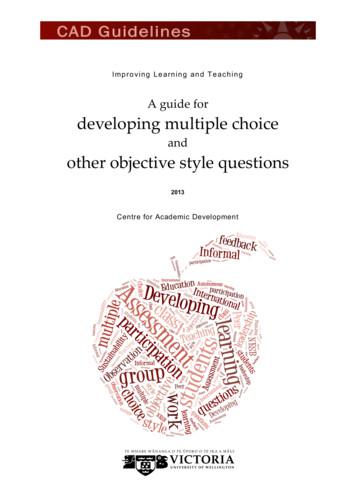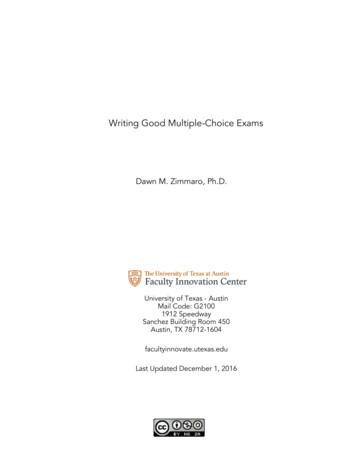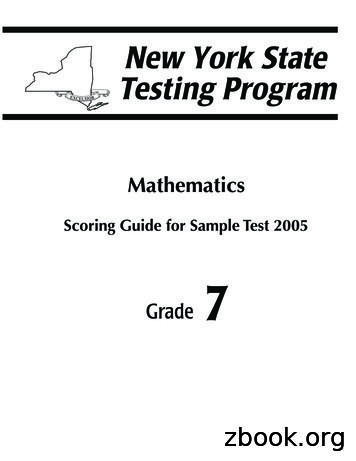Multiple Choice Questions ForReview
UNIT Lo: Multiple Choice QuestionsLectures in Discrete Mathematics, Course 1, Bender/Williamson,Review QuestionsMultiple Choice Questions for ReviewIn each case there is one correct answer (given at the end of the problem set). Tryto work the problem first without looking at the answer. Understand both why thecorrect answer is correct and why the other answers are wrong.1. Consider the statement form p q where p “If Tom is Jane’s father then Jane isBill’s niece” and q “Bill is Tom’s brother.” Which of the following statements isequivalent to this statement?(a) If Bill is Tom’s Brother, then Tom is Jane’s father and Jane is not Bill’s niece.(b) If Bill is not Tom’s Brother, then Tom is Jane’s father and Jane is not Bill’s niece.(c) If Bill is not Tom’s Brother, then Tom is Jane’s father or Jane is Bill’s niece.(d) If Bill is Tom’s Brother, then Tom is Jane’s father and Jane is Bill’s niece.(e) If Bill is not Tom’s Brother, then Tom is not Jane’s father and Jane is Bill’s niece.2. Consider the statement, “If n is divisible by 30 then n is divisible by 2 and by 3 andby 5.” Which of the following statements is equivalent to this statement?(a) If n is not divisible by 30 then n is divisible by 2 or divisible by 3 or divisible by5.(b) If n is not divisible by 30 then n is not divisible by 2 or not divisible by 3 or notdivisible by 5.(c) If n is divisible by 2 and divisible by 3 and divisible by 5 then n is divisible by 30.(d) If n is not divisible by 2 or not divisible by 3 or not divisible by 5 then n is notdivisible by 30.(e) If n is divisible by 2 or divisible by 3 or divisible by 5 then n is divisible by 30.3. Which of the following statements is the contrapositive of the statement, “You win thegame if you know the rules but are not overconfident.”(a) If you lose the game then you don’t know the rules or you are overconfident.(b) A sufficient condition that you win the game is that you know the rules or youare not overconfident.(c) If you don’t know the rules or are overconfident you lose the game.(d) If you know the rules and are overconfident then you win the game.(e) A necessary condition that you know the rules or you are not overconfident is thatyou win the game.4. The statement form (p r) (q r) is equivalent to(a) [( p r) (p r)] [( q r) (q r)](b) [( p r) (p r)] [( q r) (q r)](c) [( p r) (p r)] [( q r) (q r)](d) [( p r) (p r)] [( q r) (q r)]Lo-23
Logic(e) [( p r) (p r)] [( q r) (q r)]5. Consider the statement, “Given that people who are in need of refuge and consolationare apt to do odd things, it is clear that people who are apt to do odd things are inneed of refuge and consolation.” This statement, of the form (P Q) (Q P ), islogically equivalent to(a) People who are in need of refuge and consolation are not apt to do odd things.(b) People are apt to do odd things if and only if they are in need of refuge andconsolation.(c) People who are apt to do odd things are in need of refuge and consolation.(d) People who are in need of refuge and consolation are apt to do odd things.(e) People who aren’t apt to do odd things are not in need of refuge and consolation.6. A sufficient condition that a triangle T be a right triangle is that a2 b2 c2 . Anequivalent statement is(a) If T is a right triangle then a2 b2 c2 .(b) If a2 b2 c2 then T is a right triangle.(c) If a2 b2 6 c2 then T is not a right triangle.(d) T is a right triangle only if a2 b2 c2 .(e) T is a right triangle unless a2 b2 c2 .7. Which of the following statements is NOT equivalent to the statement, “There existseither a computer scientist or a mathematician who knows both discrete math andJava.”(a) There exists a person who is a computer scientist and who knows both discretemath and Java or there exists a person who is a mathematician and who knowsboth discrete math and Java.(b) There exists a person who is a computer scientist or there exists a person who isa mathematician who knows discrete math or who knows Java.(c) There exists a person who is a computer scientist and who knows both discretemath and Java or there exists a mathematician who knows both discrete mathand Java.(d) There exists a computer scientist who knows both discrete math and Java or thereexists a person who is a mathematician who knows both discrete math and Java.(e) There exists a person who is a computer scientist or a mathematician who knowsboth discrete math and Java.8. Which of the following is the negation of the statement, “For all odd primes p qthere exists positive non-primes r s such that p2 q 2 r 2 s2 .”(a) For all odd primes p q there exists positive non-primes r s such that p2 q 2 6 r 2 s2 .(b) There exists odd primes p q such that for all positive non-primes r s, p2 q 2 r 2 s2 .Lo-24
Review Questions(c) There exists odd primes p q such that for all positive non-primes r s, p2 q 2 6 r 2 s2 .(d) For all odd primes p q and for all positive non-primes r s, p2 q 2 6 r 2 s2 .(e) There exists odd primes p q and there exists positive non-primes r s suchthat p2 q 2 6 r 2 s29. Consider the following assertion: “The two statements(1) x D, (P (x) Q(x)) and(2) ( x D, P (x)) ( x D, Q(x)) have the sametruth value.” Which of the following is correct?(a) This assertion is false. A counterexample is D N, P (x) “x is divisible by 6,”Q(x) “x is divisible by 3.”(b) This assertion is true. The proof follows from the distributive law for .(c) This assertion is false. A counterexample is D Z, P (x) “x 0,” Q(x) “x 0.”(d) This assertion is true. To see why, let D N, P (x) “x is divisible by 6,”Q(x) “x is divisible by 3.” If x 6, then x is divisible by both 3 and 6 so bothstatements in the assertion have the same truth value for this x.(e) This assertion is false. A counterexample is D N, P (x) “x is a square,”Q(x) “x is odd.”10. Which of the following is an unsolved conjecture?n/P(a) n N, 22 1 (b) K N, n K, n odd, p, q, r P, n p q r(c) ( x, y, z, n N , xn y n z n ) (n 1, 2)(d) m N , n m, n even, p, q P, n p q(e) m N , n m, n P and n 2 P11. Which of the following is a solved conjecture?(a) m N , n m, n odd, p, q P, n p q(b) m N , n m, n P and n 2 Pn(c) m N , n m, 22 1 P(d) k N , p P, p k , 2p 1 P(e) n 4, n even , p, q P, n p qAnswers: 1 (b), 2 (d), 3 (a), 4 (e), 5 (c), 6 (b), 7 (b), 8 (c), 9 (c), 10 (e), 11 (a).Lo-25
Notation IndexLogic notation (for some) Lo-13 (for all) Lo-12 (not) Lo-2 (and) Lo-2 (if and only if) Lo-6 (or) Lo-2 (if . . . then) Lo-5N (Natural numbers) Lo-13P (Prime numbers) Lo-13R (Real numbers) Lo-13Sets of numbersN (Natural numbers) Lo-13P (Prime numbers) Lo-13R (Real numbers) Lo-13Z (Integers) Lo-13Z (Integers) Lo-13Index-1
IndexSubject IndexAbsorption ruleLo-3Algebraic rules forpredicate logic Lo-19statement forms Lo-3Associative ruleLo-3Biconditional ( if and onlyif) Lo-6Bound ruleLo-3Commutative ruleExistential quantifier ( ) Lo-13Fermat number Lo-16Fermat’s Last Theorem Lo-18For all (logic: ) Lo-12For some (logic: ) Lo-13Goldbach’s conjecture Lo-13Lo-3Composite number Lo-13Idempotent rule Lo-3If . . . then Lo-5Conditional ( if . . . then) Lo-5If and only if (logic) Lo-7ConjectureGoldbach’s Lo-13Twin Prime Lo-16Implication Lo-5InverseLo-6Contradiction Lo-2Contrapositive Lo-6ConverseLo-6DeMorgan’s ruleLo-3Distributive ruleLo-3Logicpredicate Lo-12propositional Lo-1Mersenne number Lo-17Double implication ( if and onlyif) Lo-6Double negation rule Lo-3Necessary (logic) Lo-7Negation ruleEnglish to logic“for all” Lo-12“for some” Lo-13“if and only if” Lo-7method for implication Lo-8“necessary” Lo-7“only if” Lo-7“requires” Lo-8“sufficient” Lo-7“there exists” Lo-13“unless” Lo-8Lo-3Numbercomposite Lo-13Fermat: Fn Lo-16integer: Z Lo-13Mersenne: Mp Lo-17natural: N Lo-13perfect Lo-17prime Lo-13prime: P Lo-13real: R Lo-13Index-3
IndexNumber theoryelementary Lo-13There exists (logic: )Lo-13Truth set (predicate logic) Lo-12Truth table Lo-2Only if (logic) Lo-7Perfectnumber Lo-17Predicate logicalgebraic rules Lo-19predicate Lo-12quantifier Lo-12truth set Lo-12Prime number Lo-13Propositional logic Lo-1algebraic rules Lo-3Quantifierexistential ( ) Lo-13negation of Lo-15universal ( ) Lo-12Ruleabsorption Lo-3associative Lo-3bound Lo-3commutative Lo-3DeMorgan’s Lo-3distributive Lo-3double negation Lo-3idempotent Lo-3negation Lo-3Setas a predicate Lo-14Statement form Lo-1Boolean function and Lo-8Statement variable Lo-1Sufficient (logic) Lo-7Tautology Lo-2Index-4Twin Prime conjecture Lo-16Universal quantifier ( ) Lo-12Unless (logic) Lo-8
Bill’s niece” and q “Bill is Tom’s brother.” Which of the following statements is equivalent to this statement? (a) If Bill is Tom’s Brother, then Tom is Jane’s father and Jane is not Bill’s niece. (b) If Bill is not Tom’s Brother, then Tom is Jane’s father and Jane is not Bill’s niece. (c) If Bill is not Tom’s Brother .
Developing multiple choice and other objective style questions 4 2. Writing multiple choice questions THE FORMAT of a multiple choice question Multiple choice questions are the most commonly used format for presenting objective-style questions. A multiple choice question consists of two parts ñ A stem and several options or alternatives.
Figure 1: A two-tier multiple-choice question in the format suggested in this paper, used in an exam in 2014. 2Description and design of our two-tier multiple-choice questions 2.1Basic structure of our two-tier multiple-choice questions There are several different ways to formulate two-tier multiple-choice questions. The type of
Test Blueprint 10 Preparing to Write Items 11 Description of Multiple-Choice Items 12-15 Multiple-Choice Item Writing Guidelines 16-18 Guidelines to Writing Test Items 19 Sample Multiple-Choice Items Related to Bloom’s Taxonomy 21-23 More Sample Multiple-Choice Items 24-25 Levels of Performance and Sample Prototype Items 26 Good versus Poor Multiple-Choice Items 27-28 Activity: Identifying .
Using multiple choice questions in the classroom How multiple choice questions can aid knowledge retention and help teachers diagnose pupils’ understanding. Why might I use multiple choice questions with my students?
50 multiple choice. 5. field test 40 multiple choice field test 46 ITEMS/40 POINTS 45 ITEMS/40 POINTS 55 ITEMS/50 POINTS 45 ITEMS/40 POINTS. 12 Students compose two essays one, for each of. two writing prompts. 40. multiple choice. 5. field test. 49. multiple choice. 1. open ended. 6. field test 50 multiple choice. 5. field test 40 multiple .
Grade 7, Book 1 Question Type Points Strand Content Performance Indicator Answer Key 1 Multiple Choice 1 Number Sense and Operations 7.N.9 C 2 Multiple Choice 1 Algebra 7.A.1 G 3 Multiple Choice 1 Statistics and Probability 6.S.3 A 4 Multiple Choice 1 Number Sense and Operations 7.N.6 H 5 Multiple Choice 1 Geometry 7.G.3 B
Other Species of Multiple-Choice Items In this chapter, we are concentrating on only one type of multiple-choice item—the one that has only one correct answer—but there are several other types of more complex multiple-choice items that you may want to consider. Some multiple-choice items are context
Nutrition of ruminants Developing production systems for ruminants using tropical feed resources requires an understanding of the relative roles and nutrient needs of the two-compartment system represented by the symbiotic relationship between rumen micro-organisms and the host animal. Fibre-rich, low-protein forages and crop residues are the most abundant and appropriate feeds for ruminants .























